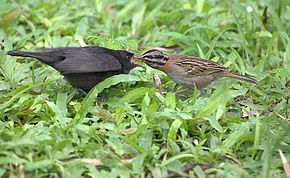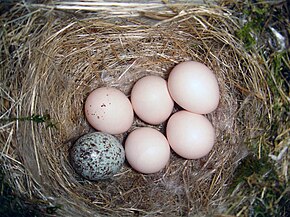
Back Broeiparasiet Afrikaans متطفلات الأعشاش Arabic বাসা পরজীবীতা Bengali/Bangla Parasitisme de posta Catalan Hnízdní parazitismus Czech Brutparasitismus German Brood parasitism English Nestoparazitado Esperanto Parasitismo de puesta Spanish Pesaparasitism Estonian


Brood parasites are animals, usually birds, which trick other species to raise their young. The best-known example is the cuckoo. Brood parasitism works because the parasite develops faster than the resident eggs, kills its nestmates and turfs them out of the nest. The adult birds cannot tell the difference in the young, and spend their time raising the offspring of another species. In some cases, the parasite has the ability to make the begging cheeps of the host species.[1][2]
The strength of defences and counter-adaptation rely on the species' ability to evolve. Some host species have very strong rejection defences. This makes the parasitic species evolving to have very close mimicry. But in other species, hosts do not reject the foreign egg. As a result, the parasitic species shows no egg mimicry.[3]
Similar methods are used by some fish and insects.
- ↑ Payne R.B. 1997. Avian brood parasitism. In D.H. Clayton and J. Moore (eds) Host-parasite evolution: general principles and avian models, 338–369. Oxford University Press.
- ↑ Sorenson M.D. and R.B. Payne 2001. A single ancient origin of brood parasitism in African finches: implications for host-parasite coevolution. Evolution: 55: 2550-2567
- ↑ Stevens, Martin (2013-10-21). "Bird brood parasitism". Current Biology. 23 (20): R909–R913. doi:10.1016/j.cub.2013.08.025. ISSN 0960-9822. PMID 24156805.